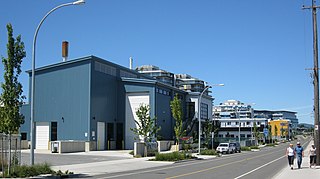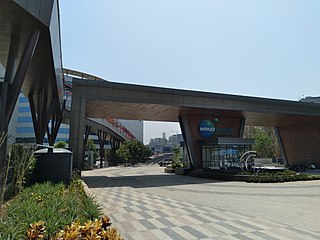Related Research Articles

Green building refers to both a structure and the application of processes that are environmentally responsible and resource-efficient throughout a building's life-cycle: from planning to design, construction, operation, maintenance, renovation, and demolition. This requires close cooperation of the contractor, the architects, the engineers, and the client at all project stages. The Green Building practice expands and complements the classical building design concerns of economy, utility, durability, and comfort. Green building also refers to saving resources to the maximum extent, including energy saving, land saving, water saving, material saving, etc., during the whole life cycle of the building, protecting the environment and reducing pollution, providing people with healthy, comfortable and efficient use of space, and being in harmony with nature. Buildings that live in harmony; green building technology focuses on low consumption, high efficiency, economy, environmental protection, integration and optimization.’

A low-energy house is characterized by an energy-efficient design and technical features which enable it to provide high living standards and comfort with low energy consumption and carbon emissions. Traditional heating and active cooling systems are absent, or their use is secondary. Low-energy buildings may be viewed as examples of sustainable architecture. Low-energy houses often have active and passive solar building design and components, which reduce the house's energy consumption and minimally impact the resident's lifestyle. Throughout the world, companies and non-profit organizations provide guidelines and issue certifications to guarantee the energy performance of buildings and their processes and materials. Certifications include passive house, BBC—Bâtiment Basse Consommation—Effinergie (France), zero-carbon house (UK), and Minergie (Switzerland).
Green development is a real estate development concept that considers social and environmental impacts of development. It is defined by three sub-categories: environmental responsiveness, resource efficiency, and community and cultural sensitivity. Environmental responsiveness respects the intrinsic value of nature, and minimizes damage to an ecosystem. Resource efficiency refers to the use of fewer resources to conserve energy and the environment. Community and cultural sensitivity recognizes the unique cultural values that each community hosts and considers them in real estate development, unlike more discernable signs of sustainability, like solar energy,. Green development manifests itself in various forms, however it is generally based on solution multipliers: features of a project that provide additional benefits, which ultimately reduce the projects' environmental impacts.

Leadership in Energy and Environmental Design (LEED) is a green building certification program used worldwide. Developed by the non-profit U.S. Green Building Council (USGBC), it includes a set of rating systems for the design, construction, operation, and maintenance of green buildings, homes, and neighborhoods, which aims to help building owners and operators be environmentally responsible and use resources efficiently.

The U.S. Green Building Council (USGBC), founded in 1993, is a private 501(c)3, membership-based non-profit organization that promotes sustainability in building design, construction, and operation. USGBC is best known for its development of the Leadership in Energy and Environmental Design (LEED) green building rating systems and its annual Greenbuild International Conference and Expo, the world's largest conference and expo dedicated to green building. USGBC was one of eight national councils that helped found the World Green Building Council (WorldGBC).

The Canada Green Building Council (CaGBC) was created in 2003 to further the expansion of green building in Canada. Prior to the formation of the Council, Canada had participated in the United States Green Building Council (USGBC) through British Columbia's membership in the USGBC's Cascadia Chapter.

Robert "Rob" Watson, is a market transformation expert, international leader in the green building movement and CEO and chief scientist of The ECON Group. He founded the LEED Green Building Rating System of the United States Green Building Council (USGBC) in 1993 and was its founding chairman until 2006.

Dockside Green is a 1,300,000-square-foot (120,000 m2) mixed-use community in Victoria, British Columbia, Canada owned by Vancity Credit Union and noted for its strict adherence to the principles of sustainable architecture or green building.
Green building on college campuses is the purposeful construction of buildings on college campuses that decreases resource usage in both the building process and also the future use of the building. The goal is to reduce CO2 emissions, energy use, and water use, while creating an atmosphere where students can be healthy and learn.
The LEED Professional Exams are administered by the Green Business Certification Inc. (GBCI) for professionals seeking to earn credentials and certificates. The exams test knowledge based on the U.S. Green Building Council's Leadership in Energy and Environmental Design (LEED) Rating Systems.
The International Green Construction Code (IGCC) is a set of guidelines that aim to improve the sustainability and environmental performance of buildings during their design, construction, and operation. It was introduced by the International Code Council (ICC), a non-profit organization that provides building safety and fire prevention codes for the United States and other countries. It is a model code designed to be mandatory where it is implemented.
LEED for Neighborhood Development (LEED-ND), where "LEED" stands for Leadership in Energy and Environmental Design, is a United States-based rating system that integrates the principles of smart growth, urbanism, and green building into a national system for neighborhood design. LEED certification provides independent, third-party verification that a development's location and design meet accepted high levels of environmentally responsible, sustainable development.
The California Green Building Standards Code is Part 11 of the California Building Standards Code and is the first statewide "green" building code in the US.

Mindspace is a brand of commercial and industrial parks established by K Raheja Corp. Located in Mumbai, Hyderabad, Chennai and Pune, the industrial hubs offer offices, residential towers, entertainment facilities and other retail businesses. By 2016, the parks developed by Mindspace housed more than 50 businesses in India, including Accenture, L&T Infotech Ltd, Cognizant Technology and Capegemini Group.

Gregory H. Kats is an American businessman, environmentalist, and thought leader in the green economy sector. He is founder and CEO of the Smart Surfaces Coalition, a non-profit organization consisting of 40+ national and international partner groups working to ensure the rapid, cost-effective adoption of reflective, porous, and green urban surface infrastructure, or "smart surfaces", in cities. Previously, Kats served as a Managing Director at Good Energies,[2] a multi-billion dollar global clean energy investor, and Director of Financing for Energy Efficiency and Renewable Energy at the U.S. Department of Energy (DOE).[3]
The House Energy Rating (HER) or House Energy Rating Scheme (HERS) are worldwide standard measures of comparison by which one can evaluate the energy efficiency of a new or an existing building. The comparison is generally done for energy requirements for heating and cooling of indoor space. The energy is the main criterion considered by any international building energy rating scheme but there are some other important factors such as production of greenhouse gases emission, indoor environment quality, cost efficiency and thermal comfort, which are considered by some schemes. Basically, the energy rating of a residential building provides detailed information on the energy consumption and the relative energy efficiency of the building. Hence, HERs inform consumers about the relative energy efficiency of homes and encourage them to use this information in making their house purchase decision.
Green Building Initiative (GBI) is a 501(c)(3) nonprofit organization that owns and administers the Green Globes green building assessment and certification in the United States and Canada. It was established in 2004 and is headquartered in Portland, Oregon.
The Green Parking Council (GPC), a nonprofit organization and affiliate of the International Parking Institute provided leadership and oversight for the green conversion of parking facilities to sustainable, environmentally responsible assets. GPC expanded green parking practices and promoted sustainable urban mobility through its Certified Green Garage rating system. The Certified Green Garage rating system was acquired by the United States Green Building Council (USGBC) and is administered by the Green Business Certification Inc. (GBCI), the certification arm of the USGBC. Rebranded and launched as the Parksmart rating system, Parksmart is now aligned with the full suite of LEED programs under the USGBC organization.
The National Green Building Standard (NGBS) is an ANSI-approved green building certification program, specifically focused on single-family and multi-family residential buildings, remodeling projects, and land developments.

Green building certification systems are a set of rating systems and tools that are used to assess a building or a construction project's performance from a sustainability and environmental perspective. Such ratings aim to improve the overall quality of buildings and infrastructures, integrate a life cycle approach in its design and construction, and promote the fulfillment of the United Nations Sustainable Development Goals by the construction industry. Buildings that have been assessed and are deemed to meet a certain level of performance and quality, receive a certificate proving this achievement.
References
- ↑ "Office of Federal High-Performance Buildings". www.gsa.gov. Retrieved 26 July 2017.
- ↑ "SFTool - Sustainable Facilities Tool - GSA Sustainable Facilities Tool". sftool.gov. Retrieved 26 July 2017.
- ↑ NAHBGreen - National Green Building Program | national green building standard certification nahb research center program homes residential builders remodelers scoring tool co...
- ↑ "Green Building Initiative" . Retrieved 2011-05-13.
- ↑ "Green Technology News". Archived from the original on 2008-10-17. Retrieved 2008-11-25. Green Technology.
- 1 2 eSchool News Archived September 17, 2008, at the Wayback Machine
- ↑ http://thomas.loc.gov/cgi-bin/bdquery/z?d110:h.r.03021 Archived 2016-04-08 at the Wayback Machine : THOMAS Library of Congress.
- ↑ Myerson, Deborah L. (2008). ULI Community Catalyst Report Number 7: Environmentally Sustainable Affordable Housing. Washington D.C.: ULI - the Urban Land Institute.
- ↑ Enterprise Community Partners. "About". Green Communities. Retrieved 3 December 2011.
- ↑ Rappaport, Ann (January–February 2008). "Campus Greening: Behind the Headlines". Environment . 50 (1): 6–16. Retrieved 2009-04-22.
- ↑ Oregon Housing and Community Services (May 7, 2007). "Green Building in Oregon: Green Building Activities". Salem, OR, USA: State of Oregon . Retrieved 7 December 2011.
- ↑ Office of Housing, City of Seattle. "SeaGreen: Sustainability & Conservation". Seattle, WA, USA: City of Seattle. Retrieved 7 December 2011.
- ↑ Department of Neighborhood Development, City of Boston. "Green Housing Program". Boston, MA, USA: City of Boston . Retrieved 7 December 2011.
- ↑ Developer Achieves Sustainable Development Distinction Unique in Development Industry Archived 2011-09-13 at the Wayback Machine , press release, May 6, 2011.
- ↑ HCD, California Department of Housing and Community Development -. "HCD Page Not Found" (PDF). www.hcd.ca.gov. Archived from the original (PDF) on 2 March 2011. Retrieved 26 July 2017.
{{cite web}}: Cite uses generic title (help) - ↑ "EERE News: EERE Network News - September 03, 2008". Archived from the original on 15 September 2008.
- ↑ "GreenPoint Rated". www.builditgreen.org. Retrieved 26 July 2017.
- ↑ "Build It Green". www.builditgreen.org. Retrieved 26 July 2017.
- ↑ Freed, Jason Q. (2008-04-21). "Speakers break down costs of going green". Hotel & Motel Management . Vol. 233, no. 7. Henderson, NV. pp. 1, 32. Retrieved 2009-04-23.[ dead link ]
- ↑ Albemarle examines cost, benefits of green buildings Archived 2008-12-26 at the Wayback Machine , Charlottesville Tomorrow, 2007-04-20. Retrieved 2007-05-03
- ↑ Energy Roundup, Wall Street Journal Energy Roundup, 2007-05-03. Retrieved 2007-05-03
- ↑ The Power of Small Communities to LEED Change: Charlottesville, VA, Energy Spin, 2007-05-03. Retrieved 2007-05-03 Archived April 12, 2008, at the Wayback Machine
- ↑ Washington State Law Mandates Green Building Archived 2007-05-03 at the Wayback Machine , RenewableEnergyAccess, 2005-04-21. Retrieved 2007-02-10